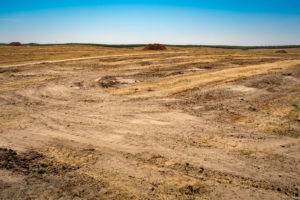Walnut grower Craig McNamara often gets asked about his father, Robert McNamara, former U.S. secretary of defense (1961—68) and World Bank president (1968—81). But the younger McNamara lives far removed from the halls of power in Washington: Since buying his Solano County farm on Putah Creek in 1980, he’s had his hands full with 26 harvests. He also runs the Center for Land-Based Learning, a nonprofit that connects people to agriculture through hands-on educational programs. In 2003 he built a system of ponds to recycle nutrients and water and provide wildlife habitat. We interviewed McNamara on his farm during January’s cold snap.
BN: Tell us a bit about the farm.
CM: We farm about 450 acres, half in walnuts, the other half in row crops. Putah Creek, on the northern border of the ranch, flows to the Yolo Wildlife Area east of Davis, into the Sacramento River, out through the Delta, and into San Francisco Bay.
We have two ponds on the farm. One was originally a reservoir at the end of the row-crop field. All of the unused irrigation water went into this reservoir, but overflow went back into Putah Creek. About 10 years ago we created a meandering stream that flows into the reservoir and planted it with California native trees and shrubs. We maintained it for a few years, but now it has gone pretty wild and native. Our next adventure was to build the sediment trap and tailwater pond in 2003. That was a much larger and costlier project—it cost about $30,000, and we removed two acres from production.
BN: How does it work?
CM: Irrigation water flows into the field and drains into the sediment trap. Excess water spills over into the main pond. In the fall and winter, when the sediment trap is dry, we take out the sediment for topsoil, instead of sending it back into the stream and the bay.
Our goal is to keep all the rain and irrigation water on the property. The pond is also a perfect demonstration project. High school students in our programs planted and maintained all of the hedgerows and installed the irrigation systems.
BN: Why hedgerows?
CM: Native-plant hedgerows reintroduce biodiversity in an area that has been denuded of it. Back in the 1970s, Secretary of Agriculture Earl Butts said, “Let’s farm fence post to fence post to utilize all of America’s farmland.” So farmers pretty much got rid of all the native grasses and diverse areas for bird and insect life. We’ve come to realize over the last 25 years that habitat is hugely important, and farmers are doing more to reintroduce it on our farms. It provides nectar sources for beneficial insects to combat pest populations, and it attracts birds that feed on insects that are potentially damaging the crops.
BN: Were the ponds designed with wildlife habitat in mind?
CM: Not necessarily the four-legged kind, but from a raptor, reptile, and insect standpoint, yes. Typically what happens in a production area is that the pest population will get ahead of the beneficial population, since the beneficial population needs to have an energy source to thrive. We’re trying to balance that out.
BN: Do you use any chemical inputs? Do you take measures to keep residues out of the ponds?
CM: Actually, it’s just the reverse. That’s what the pond is for. As a demonstration farm, we maintain a balance of conventional and organic farming. Our organic walnut field is all drip and doesn’t have any runoff. The tailwater [from the row crop field] is going to pick up fertilizers, herbicides, or pesticides. And that’s precisely the idea. The pond and the land underneath it are filtering residues, and the goal is to have little or no outflow.
BN: Have the ponds attracted a lot of wildlife?
CM: Robert Bugg, a biologist with UC Davis, told us he’s excited about the population and density of frogs. [Bugg confirmed with Bay Nature that the pond, in hopping distance of Putah Creek, has Western toads, once abundant in the Central Valley but now considered rare.] And we have Swainson’s, Cooper’s, and redtailed hawks, bluebirds, egrets, herons, and lots of barn owls. A great blue heron and a great egret have cohabited in the pond for over a year. We call them “the Odd Couple.” It’s interesting to me that an egret or a heron or another bird would come to the pond when they have Putah Creek less than half a mile away, but they do. The pond is a home, or at least a resting area, for quite a bit of birdlife.
Go to the Land-Based Learning website to find out more.

.jpg)



